组合数学(第5章5.2)
- 格式:ppt
- 大小:130.50 KB
- 文档页数:23
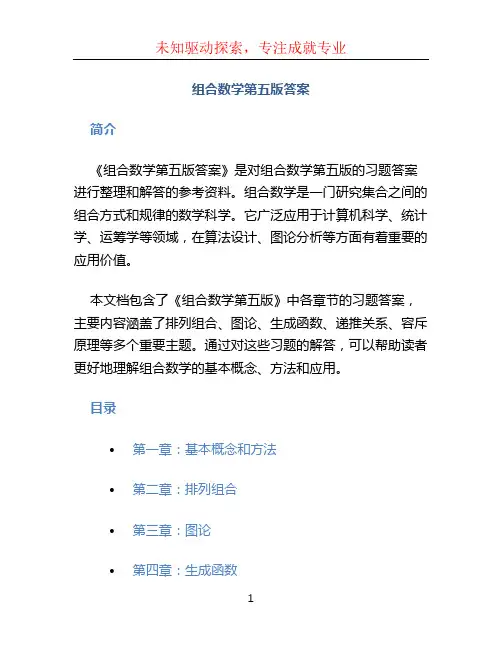
组合数学第五版答案简介《组合数学第五版答案》是对组合数学第五版的习题答案进行整理和解答的参考资料。
组合数学是一门研究集合之间的组合方式和规律的数学科学。
它广泛应用于计算机科学、统计学、运筹学等领域,在算法设计、图论分析等方面有着重要的应用价值。
本文档包含了《组合数学第五版》中各章节的习题答案,主要内容涵盖了排列组合、图论、生成函数、递推关系、容斥原理等多个重要主题。
通过对这些习题的解答,可以帮助读者更好地理解组合数学的基本概念、方法和应用。
目录•第一章:基本概念和方法•第二章:排列组合•第三章:图论•第四章:生成函数•第五章:递推关系•第六章:容斥原理第一章:基本概念和方法1.习题1:证明排列的总数为n! (阶乘)。
2.习题2:计算组合数C(n, m)的值。
3.习题3:探究组合数的性质并给出证明。
第二章:排列组合1.习题1:计算排列数P(n, m)的值。
2.习题2:解决带有限制条件的排列问题。
第三章:图论1.习题1:证明图论中的握手定理。
2.习题2:解决图的着色问题。
第四章:生成函数1.习题1:利用生成函数求解递推关系。
2.习题2:应用生成函数解决组合数学问题。
第五章:递推关系1.习题1:求解递推关系的通项公式。
2.习题2:应用递推关系解决实际问题。
第六章:容斥原理1.习题1:理解容斥原理的基本思想并给出证明。
2.习题2:应用容斥原理解决计数问题。
结论通过对《组合数学第五版答案》中的习题进行解答,读者可以更好地掌握组合数学的基本概念和方法。
组合数学在计算机科学、统计学、运筹学等领域具有广泛的应用,通过学习和理解组合数学,读者可以提高解决实际问题的能力,并为进一步深入研究相关领域打下坚实的基础。
注:本文档中的习题答案仅供参考,请读者在独立思考和解答问题时加以思考和验证,以深入理解组合数学的核心概念和方法。
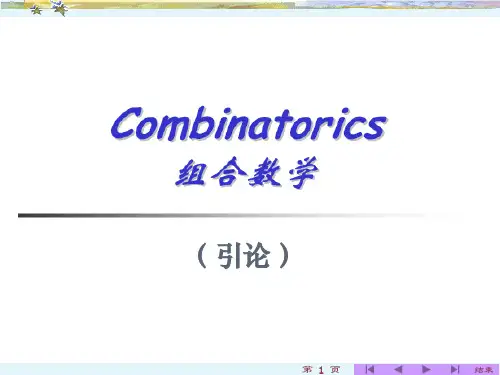

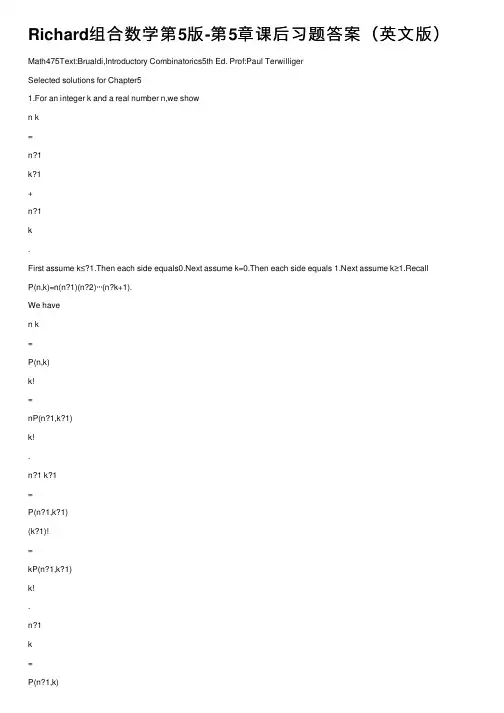
Richard组合数学第5版-第5章课后习题答案(英⽂版)Math475Text:Brualdi,Introductory Combinatorics5th Ed. Prof:Paul TerwilligerSelected solutions for Chapter51.For an integer k and a real number n,we shown k=n?1k?1+n?1k.First assume k≤?1.Then each side equals0.Next assume k=0.Then each side equals 1.Next assume k≥1.RecallP(n,k)=n(n?1)(n?2)···(n?k+1).We haven k=P(n,k)k!=nP(n?1,k?1)k!.n?1 k?1=P(n?1,k?1)(k?1)!=kP(n?1,k?1)k!.n?1k(n?k)P(n?1,k?1)k!.The result follows.2.Pascal’s triangle begins111121133114641151010511615201561172135352171182856705628811936841261268436911104512021025221012045101···13.Let Z denote the set of integers.For nonnegative n∈Z de?ne F(n)=k∈Zn?kk.The sum is well de?ned since?nitely many summands are nonzero.We have F(0)=1and F(1)=1.We show F(n)=F(n?1)+F(n?2)for n≥2.Let n be /doc/6215673729.htmling Pascal’s formula and a change of variables k=h+1,F(n)=k∈Zn?kk=k∈Zn?k?1k?1=k∈Zn?k?1k+h∈Zn?h?2h=F(n?1)+F(n?2).Thus F(n)is the n th Fibonacci number.4.We have(x+y)5=x5+5x4y+10x3y2+10x2y3+5xy4+y5and(x+y)6=x6+6x5y+15x4y2+20x3y3+15x2y4+6xy5+y6.5.We have(2x?y)7=7k=07k27?k(?1)k x7?k y k.6.The coe?cient of x5y13is35(?2)13 185.The coe?cient of x8y9is0since8+9=18./doc/6215673729.htmling the binomial theorem,3n=(1+2)n=nk=0nSimilarly,for any real number r,(1+r)n=nk=0nkr k./doc/6215673729.htmling the binomial theorem,2n=(3?1)n=nk=0(?1)knk3n?k.29.We haven k =0(?1)k nk 10k =(?1)n n k =0(?1)n ?k n k 10k =(?1)n (10?1)n =(?1)n 9n .The sum is 9n for n even and ?9n for n odd.10.Given integers 1≤k ≤n we showk n k =n n ?1k ?1.Let S denote the set of ordered pairs (x,y )such that x is a k -subset of {1,2,...,n }and yis an element of x .We compute |S |in two ways.(i)To obtain an element (x,y )of S there are n k choices for x ,and for each x there are k choices for y .Therefore |S |=k n k .(ii)Toobtain an element (x,y )of S there are n choices for y ,and for each y there are n ?1k ?1 choices for x .Therefore |S |=n n ?1k ?1.The result follows.11.Given integers n ≥3and 1≤k ≤n .We shown k ? n ?3k = n ?1k ?1 + n ?2k ?1 + n ?3k ?1.Let S denote the set of k -subsets of {1,2,...,n }.Let S 1consist of the elements in S thatcontain 1.Let S 2consist of the elements in S that contain 2but not 1.Let S 3consist of the elements in S that contain 3but not 1or 2.Let S 4consist of the elements in S that do|S |= n k ,|S 1|= n ?1k ?1 ,|S 2|= n ?2k ?1 ,|S 3|= n ?3k ?1 ,|S 4|= n ?3k .The result follows.12.We evaluate the sumnk =0(?1)k nk 2.First assume that n =2m +1is odd.Then for 0≤k ≤m the k -summand and the (n ?k )-summand are opposite.Therefore the sum equals 0.Next assume that n =2m is even.Toevaluate the sum in this case we compute in two ways the the coe?cient of x n in (1?x 2)n .(i)By the binomial theorem this coe?cient is (?1)m 2m m .(ii)Observe (1?x 2)=(1+x )(1?x ).We have(1+x )n =n k =0n k x k,(1?x )n =n k =0nk (?1)k x k .3By these comments the coe?cient of x n in(1?x2)n isn k=0nn?k(?1)knk=nk=0(?1)knk2.2=(?1)m2mm.13.We show that the given sum is equal ton+3k .The above binomial coe?cient is in row n+3of Pascal’s /doc/6215673729.htmling Pascal’s formula, write the above binomial coe?cient as a sum of two binomial coe?ents in row n+2of Pascal’s triangle.Write each of these as a sum of two binomial coe?ents in row n+1of Pascal’s triangle.Write each of these as a sum of two binomial coe?ents in row n of Pascal’s triangle.The resulting sum isn k+3nk?1+3nk?2+nk?3.14.Given a real number r and integer k such that r=k.We showr k=rr?kr?1k.First assume that k≤?1.Then each side is0.Next assume that k=0.Then each side is 1.Next assume that k≥1.ObserverP(r?1,k?1)k!,andr?1k=P(r?1,k)k!=(r?k)P(r?1,k?1)k!.The result follows.15.For a variable x consider(1?x)n=nk=0nk(?1)k x k.4Take the derivative with respect to x and obtain n(1x)n1=nk=0nk(?1)k kx k?1.Now set x=1to get(?1)k k.The result follows.16.For a variable x consider(1+x)n=nk=0nkx k.Integrate with respect to x and obtain(1+x)n+1 n+1=nk=0nkx k+1k+1+Cfor a constant C.Set x=0to?nd C=1/(n+1).Thus (1+x)n+1?1n+1=nk=0nkx k+1k+1.Now set x=1to get2n+1?1 n+1=k+1.17.Routine.18.For a variable x consider(x?1)n=nk=0nk(?1)n?k x k.Integrate with respect to x and obtain(x?1)n+1 n+1=nk=0nk(?1)n?kx k+1k+1+Cfor a constant C.Set x=0to?nd C=(?1)n+1/(n+1).Thus (x?1)n+1?(?1)n+1n+1=nk=0nk(?1)n?kx k+1k+1Now set x =1to get(?1)n n +1=n k =0n k(?1)n ?k 1k +1.Therefore1n +1=n k =0 n k (?1)k 1k +1 .19.One readily checks2 m 2 + m 1=m (m ?1)+m =m 2.Therefore n k =1k 2=nk =0k 2=2nk =0 k 2 +n k =0k1=2 n +13 +n +12 =(n +1)n (2n +1)6.20.One readily checksm 3=6 m 3 +6 m 2 + m1.Thereforen k =1k3=n=6nk =0 k3+6n k =0 k2 +n k =0k1 =6 n +14 +6 n +13 +n +12 =(n +1)2n 24= n +12 2.621.Given a real number r and an integer k .We showrk=(?1)kr +k ?1k .First assume that k <0.Then each side is zero.Next assume that k ≥0.Observe r k =(r )(r 1)···(r k +1)k !=(?1)kr (r +1)···(r +k ?1)k !=(?1)kr +k ?1k.22.Given a real number r and integers k,m .We showr m m k = r k r ?km ?k.First assume that mObserver m m k =r (r ?1)···(r ?m +1)m !m !k !(m ?k )!=r (r ?1)···(r ?k +1)k !(r ?k )(r ?k ?1)···(r ?m +1)(m ?k )!= r k r ?k m ?k .23.(a) 2410.(b) 94 156.(c) 949363.(d)94156949363.24.The number of walks of length 45is equal to the number of words of length 45involving10x ’s,15y ’s,and 20z ’s.This number is45!10!×15!×20!.725.Given integers m 1,m 2,n ≥0.Shown k =0m 1k m 2n ?k = m 1+m 2n .Let A denote a set with cardinality m 1+m 2.Partition A into subsets A 1,A 2with cardinalitiesm 1and m 2respectively.Let S denote the set of n -subsets of A .We compute |S |in two ways.(i)By construction|S |= m 1+m 2n .(ii)For 0≤k ≤n let the set S k consist of the elements in S whose intersection with A 1has cardinality k .The sets {S k }n k =0partition S ,so |S |= nk =0|S k |.For 0≤k ≤n we now compute |S k |.To do this we construct an element x ∈S k via the following 2-stage procedure: stage to do #choices 1pick x ∩A 1 m 1k2The number |S k |is the product of the entries in the right-most column above,which comes to m 1k m 2n ?k .By these comments |S |=n k =0m 1k m 2n ?k .The result follows.26.For an integer n ≥1shown k =1 n k n k ?1 =12 2n +2n +1 ? 2n n .Using Problem 25,n k =1 n k nk ?1 =n k =0n k n k ?1 =n k =0n k nn +1?k =2n n +1 =12 2n n ?1 +12 2n n +1.8It remains to show12 2nn ?1 +12 2n n +1 =12 2n +2n +1 ? 2n n.This holds since2n n ?1 +2 2n n + 2n n +1 = 2n +1n +2n +1n +1= 2n +2n +1.27.Given an integer n ≥1.We shown (n +1)2n ?2=nk =1Let S denote the set of 3-tuples (s,x,y )such that s is a nonempty subset of {1,2,...,n }and x,y are elements (not necessarily distinct)in s .We compute |S |in two ways.(i)Call an element (s,x,y )of S degenerate whenever x =y .Partition S into subsets S +,S ?with S +(resp.S ?)consisting of the degenerate (resp.nondegenerate)elements of S .So |S |=|S +|+|S ?|.We compute |S +|.To obtain an element (s,x,x )of S +there are n choices for x ,and given x there are 2n ?1choices for s .Therefore |S +|=n 2n ?1.We compute |S ?|.To obtain an element (s,x,y )of S ?there are n choices for x,and given x there are n ?1choices for y ,and given x,y there are 2n ?2choices for s .Therefore |S ?|=n (n ?1)2n ?2.By these comments|S |=n 2n ?1+n (n ?1)2n ?2=n (n +1)2n ?2.(ii)For 1≤k ≤n let S k denote the set of elements (s,x,y )in S such that |s |=k .Thesets {S k }nk =1give a partition of S ,so |S |= n k =1|S k |.For 1≤k ≤n we compute |S k |.To obtain an element (s,x,y )of S k there are n k choices for s ,and given s there are k 2ways to choose the pair x,y .Therefore |S k |=k 2 nk .By these comments|S |=n k =1k 2 n k .The result follows.28.Given an integer n ≥1.We shown k =1k n k 2=n 2n ?1n ?1 .Let S denote the set of ordered pairs (s,x )such that s is a subset of {±1,±2,...,±n }andx is a positive element of s .We compute |S |in two ways.(i)To obtain an element (s,x )of S There are n choices for x ,and given x there are 2n ?1n ?1 choices for s .Therefore|S |=n 2n ?1n ?1.9(ii)For1≤k≤n let S k denote the set of elements(s,x)in S such that s contains exactlyk positive elements.The sets{S k}nk=1partition S,so|S|=nk=1|S k|.For1≤k≤nwe compute|S k|.To obtain an element(s,x)of S k there are nkways to pick the positiveelements of s and nn?kways to pick the negative elements of s.Given s there are kways to pick x.Therefore|S k|=k nk2.By these comments |S|=nk=1knk2.The result follows.29.The given sum is equal tom2+m2+m3n .To see this,compute the coe?cient of x n in each side of(1+x)m1(1+x)m2(1+x)m3=(1+x)m1+m2+m3.In this computation use the binomial theorem.30,31,32.We refer to the proof of Theorem5.3.3in the text.Let A denote an antichain such that|A|=nn/2.For0≤k≤n letαk denote the number of elements in A that have size k.Sonk=0αk=|A|=nn/2.As shown in the proof of Theorem5.3.3,≤1,with equality if and only if each maximal chain contains an element of A.By the above commentsnk=0αknn/2nknk≤0,with equality if and only if each maximal chain contains an element of A.The above sum is nonpositive but each summand is nonnegative.Therefore each summand is zero and the sum is zero.Consequently(a)each maximal chain contains an element of A;(b)for0≤k≤n eitherαk is zero or its coe?cient is zero.We now consider two cases.10Case:n is even.We show that for0≤k≤n,αk=0if k=n/2.Observe that for0≤k≤n, if k=n/2then the coe?cient ofαk isnonzero,soαk=0.Case:n is odd.We show that for0≤k≤n,eitherαk=0if k=(n?1)/2orαk=0 if k=(n+1)/2.Observe that for0≤k≤n,if k=(n±1)/2then the coe?cient ofαk is nonzero,soαk=0.We now show thatαk=0for k=(n?1)/2or k=(n+1)/2. To do this,we assume thatαk=0for both k=(n±1)/2and get a contradiction.By assumption A contains an element x of size(n+1)/2and an element y of size(n?1)/2. De? ne s=|x∩y|.Choose x,y such that s is maximal.By construction0≤s≤(n?1)/2. Suppose s=(n?1)/2.Then y=x∩y?x,contradicting the fact that x,y are incomparable. So s≤(n?3)/2.Let y denote a subset of x that contains x∩y and has size(n?1)/2. Let x denote a subset of y ∪y that contains y and has size(n+1)/2.By construction |x ∩y|=s+1.Observe y is not in A since x,y are comparable.Also x is not in A by the maximality of s.By construction x covers y so they are together contained in a maximal chain.This chain does not contain an element of A,for a contradiction.33.De?ne a poset(X,≤)as follows.The set X consists of the subsets of{1,2,...,n}. For x,y∈X de?ne x≤y whenever x?y.Forn=3,4,5we display a symmetric chain decomposition of this poset.We use the inductive procedure from the text.For n=3,,1,12,1232,233,13.For n=4,,1,12,123,12344,14,1242,23,23424,For n=5,,1,12,123,1234,123455,15,125,12354,14,124,124545,1452,23,234,234525,23524,2453,13,134,134535,13534,345.1134.For 0≤k ≤ n/2 there are exactlyn kn k ?1symmetric chains of length n ?2k +1.35.Let S denote the set of 10jokes.Each night the talk show host picks a subset of S for his repertoire.It is required that these subsets form an antichain.By Corollary 5.3.2each antichain has size at most 105 ,which is equal to 252.Therefore the talk show host can continue for 252nights./doc/6215673729.htmlpute the coe?cient of x n in either side of(1+x )m 1(1+x )m 2=(1+x )m 1+m 2,In this computation use the binomial theorem.37.In the multinomial theorem (Theorem 5.4.1)set x i =1for 1≤i ≤t .38.(x 1+x 2+x 3)4is equal tox 41+x 42+x 43+4(x 31x 2+x 31x 3+x 1x 32+x 32x 3+x 1x 33+x 2x 33)+6(x 21x 22+x 21x 23+x 22x 23)+12(x 21x 2x 3+x 1x 22x 3+x 1x 2x 23).39.The coe?cient is10!3!×1!×4!×0!×2!which comes to 12600.40.The coe?cient is9!3!×3!×1!×2!41.One routinely obtains the multinomial theorem (Theorem 5.4.1)with t =3.42.Given an integer t ≥2and positive integers n 1,n 2,...,n t .De?ne n = ti =1n i .We shownn 1n 2···n t=t k =1n ?1n 1···n k ?1n k ?1n k +1···n t.Consider the multiset{n 1·x 1,n 2·x 2,...,n t ·x t }.Let P denote the set of permutations of this multiset.We compute |P |in two ways.(i)We saw earlier that |P |=n !n 1!×n 2!×···×n t != n n 1n 2···n t.12(ii)For1≤k≤t let P k denote the set of elements in P that have?rst coordinate x k.Thesets{P k}tk=1partition P,so|P|=tk=1|P k|.For1≤k≤t we compute|P k|.Observe that|P k|is the number of permutations of the multiset{n1·x1,...,n k?1·x k?1,(n k?1)·x k,n k+1·x k+1,...,n t·x t}. Therefore|P k|=n?1n1···n k?1n k?1n k+1···n t.By these comments|P|=tn1···n k?1n k?1n k+1···n t.The result follows.43.Given an integer n≥1.Show by induction on n that1 (1?z)n =∞k=0n+k?1kz k,|z|<1.The base case n=1is assumed to hold.We show that the above identity holds with n replaced by n+1,provided that it holds for n.Thus we show1(1?z)n+1=∞=0n+z ,|z|<1.Observe1(1?z)n+1=1(1?z)n11?z=∞k=0n+k?1kz k∞h=0z h=0c zwherec =n?1+n1+n+12+···+n+ ?1=n+.The result follows.1344.(Problem statement contains typo)The given sum is equal to (?3)n .Observe (?3)n =(?1?1?1)n=n 1+n 2+n 3=nnn 1n 2n 3(?1)n 1+n 2+n 3=n 1+n 2+n 3=nnn 1+n 2+n 3=nnn 1n 2n 3(?1)n 2.45.(Problem statement contains typo)The given sum is equal to (?4)n .Observe (?4)n =(?1?1?1?1)n=n 1+n 2+n 3+n 4=nnn 1n 2n 3n 4(?1)n 1+n 2+n 3+n 4=n 1+n 2+n 3+n 4=nnn 1n 2n 3n 4(?1)n 1?n 2+n 3?n 4.Also0=(1?1+1?1)n= n 1+n 2+n 3+n 4=nnn 1n 2n 3n 4(?1)n 2+n 4.46.Observe√30=5=5∞ k =01/2k z k.For n =0,1,2,...the n th approximation to √30isa n =5n k =0 1/2k 5?k.We have14n a n051 5.52 5.4753 5.47754 5.47718755 5.477231256 5.4772246887 5.4772257198 5.4772255519 5.477225579 47.Observe101/3=21081/3=2(1+z)1/3z=1/4,=2∞k=01/3kz k.For n=0,1,2,...the n th approximation to101/3isnk=01/3k4?k.We haven a n021 2.1666666672 2.1527777783 2.1547067904 2.1543852885 2.1544442306 2.1544327697 2.1544350898 2.1544346059 2.15443470848.We show that a poset with mn+1elements has a chain of size m+1or an antichain of size n+1.Our strategy is to assume the result is false,and get a contradiction.By assumption each chain has size at most m and each antichain has size at most n.Let r denote the size of the longest chain.So r≤m.By Theorem5.6.1the elements of the posetcan be partitioned into r antichains{A i}ri=1.We have|A i|≤n for1≤i≤r.Thereforemn+1=ri=1|A i|≤rn≤mn, 15for a contradiction.Therefore,the poset has a chain of size m+1or an antichain of size n+1.49.We are given a sequence of mn+1real numbers,denoted{a i}mni=0.Let X denote the setof ordered pairs{(i,a i)|0≤i≤mn}.Observe|X|=mn+1.De?ne a partial order≤on X as follows:for distinct x=(i,a i)and y=(j,a j)in X,declare xof{a i}mni=0,and the antichains correspond to the(strictly)decreasing subsequences of{a i}mni=0sequence{a i}mni=0has a(weakly)increasing subsequence of size m+1or a(strictly)decreasingsubsequence of size n+1.50.(i)Here is a chain of size four:1,2,4,8.Here is a partition of X into four antichains:8,124,6,9,102,3,5,7,111Therefore four is both the largest size of a chain,and the smallest number of antichains that partition X. (ii)Here is an antichain of size six:7,8,9,10,11,12.Here is a partition of X into six chains:1,2,4,83,6,1295,10711Therefore six is both the largest size of an antichain,and the smallest number of chains that partition X.51.There exists a chain x116。
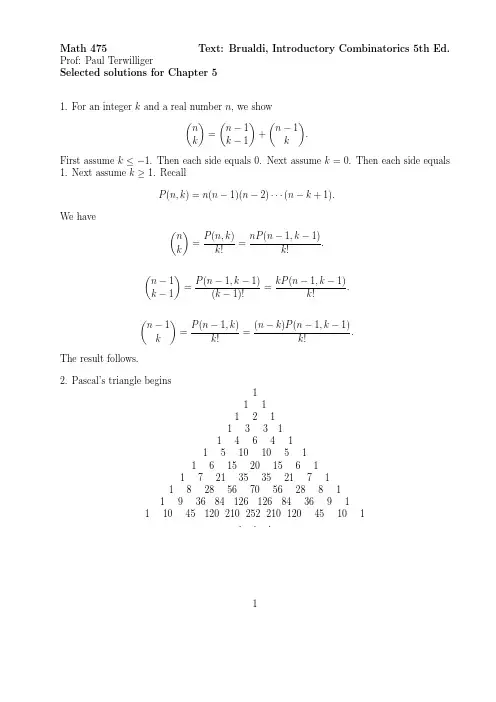

{}1 ,,n a n b n c n a ⋅⋅⋅、从中取出个字母,要求的个数为偶数,问有多少种取法?
2 a b c d e n a b 、由字母,,,,组成的长为的字中,要求与的个数之和为偶数,问这样的字有多少个?
{}123412123,,,1,2,3,41,2,3,41,2,451,2,3,410n i i i S e e e e a S n e i e i e e e e e i ∞⋅∞⋅∞⋅∞⋅===、设多重集合=,表示集合满足下列条件的组合数,分别求数列的生成函数:
(1)每个()出现奇数次;
(2)每个()出现3的倍数次;
(3)不出现,至多出现次;
(4)出现13或11次,出现或次;
(5)每个()至少出现次。
{}124,,
,1,2,
,1,2,
,k n i i S e e e a S n S S e i k i e i k i ∞⋅∞⋅∞⋅==、设多重集合=,表示集合满足下列条件的组合数,分别求数列的指数型生成函数:
(1)的每个元素出现奇数次;
(2)的每个元素至少出现4次;
(3)()至少出现次;(4)()至多出现次.
5、设有砝码重为1g 的3个,重为2g 的4个,重为4g 的2个,问能称出多少重量?各有几种方案?
6⨯、如果要把棋盘上偶数个方格涂成红色,试确定用红色、白色和蓝色对1n 棋盘的方格涂色的方法数。

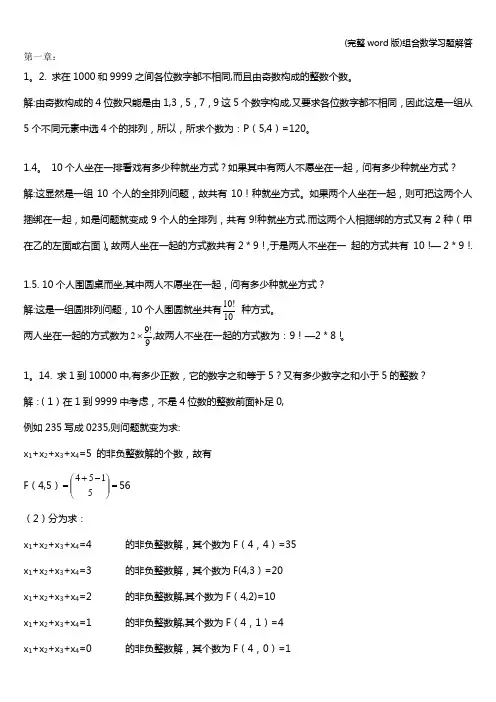
第一章:1。
2. 求在1000和9999之间各位数字都不相同,而且由奇数构成的整数个数。
解:由奇数构成的4位数只能是由1,3,5,7,9这5个数字构成,又要求各位数字都不相同,因此这是一组从5个不同元素中选4个的排列,所以,所求个数为:P (5,4)=120。
1.4。
10个人坐在一排看戏有多少种就坐方式?如果其中有两人不愿坐在一起,问有多少种就坐方式? 解:这显然是一组10个人的全排列问题,故共有10!种就坐方式。
如果两个人坐在一起,则可把这两个人捆绑在一起,如是问题就变成9个人的全排列,共有9!种就坐方式.而这两个人相捆绑的方式又有2种(甲在乙的左面或右面)。
故两人坐在一起的方式数共有2*9!,于是两人不坐在一 起的方式共有 10!— 2*9!.1.5. 10个人围圆桌而坐,其中两人不愿坐在一起,问有多少种就坐方式? 解:这是一组圆排列问题,10个人围圆就坐共有10!10 种方式。
两人坐在一起的方式数为9!92⨯,故两人不坐在一起的方式数为:9!—2*8!。
1。
14. 求1到10000中,有多少正数,它的数字之和等于5?又有多少数字之和小于5的整数? 解:(1)在1到9999中考虑,不是4位数的整数前面补足0, 例如235写成0235,则问题就变为求: x 1+x 2+x 3+x 4=5 的非负整数解的个数,故有F (4,5)=⎪⎪⎭⎫⎝⎛-+=515456 (2)分为求:x 1+x 2+x 3+x 4=4 的非负整数解,其个数为F (4,4)=35 x 1+x 2+x 3+x 4=3 的非负整数解,其个数为F(4,3)=20 x 1+x 2+x 3+x 4=2 的非负整数解,其个数为F (4,2)=10 x 1+x 2+x 3+x 4=1 的非负整数解,其个数为F (4,1)=4 x 1+x 2+x 3+x 4=0 的非负整数解,其个数为F (4,0)=1将它们相加即得,F (4,4)+F(4,3)+F (4,2)+F (4,1)+F (4,0)=70。

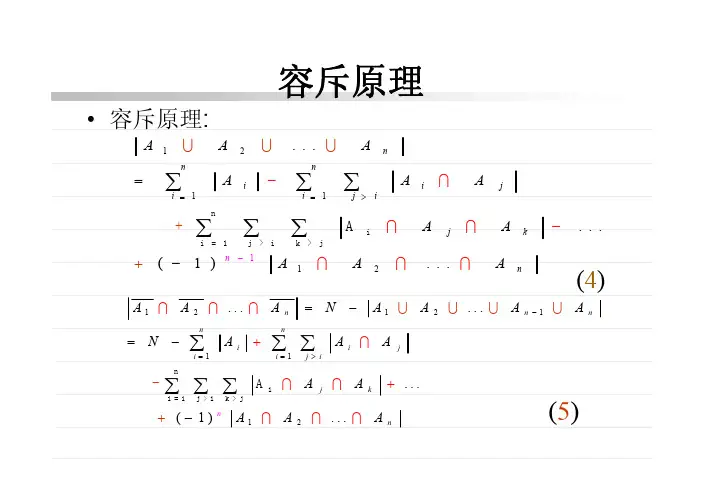
容斥原理§3.6 广义的容斥原理§3.6 广义的容斥原理ii=0•例某校有12个教师,已知教数学的有8位,教物理的§3.7 容斥原理应用举例(10,5)§3.7 容斥原理应用举例(10,5)例第二类Stirling数的展开式•例第二类Stirling数的展开式§3.7 容斥原理应用举例§3.7 容斥原理应用举例§3.7 容斥原理应用举例§3.7 容斥原理应用举例§3.7 容斥原理应用举例设A为a= i 或i+ 1 (1≤i ≤n-1 ),a= n 或1的排列§3.7 容斥原理应用举例•从1 , 2 , 2 , 3 ,3 ,4, ···,n-1, n-1, n , n , 1§3.8 Mǒbíus反演§3.8 Mǒbíus反演与Mǒbíus函数密切相关的另一类数论函数是Euler函数§3.8 Mǒbíus反演∑∑nd nd dd| |∑∑nd nd dd||“⇐”:设(M)成立。
则§3.8 Mǒbíus反演nf ( n ) = ∑g (d ) = ∑g ( ) (M)§3.8 Mǒbíus反演§3.8 Mǒbíus反演§3.8 Mǒbíus反演§3.8 Mǒbíus反演§3.8 Mǒbíus反演§3.8 Mǒbíus反演设长度为n 的圆排列的个数为T( n ),则T( n ) =∑M( d )d |n例m = { 1 , 2 } ,n = 7 则M ( 7 ) = ( 27-2 ) = 18T ( 7 ) = ∑M( d ) = M (1 ) + M ( 7) = 20d |717例m = { 1 , 2 , 3} ,n = 4 则M ( 4 ) = 1/4( 34-32) = 18T ( 4 ) = ∑M( d ) = M (1 ) + M(2) + M (4) = 24d |4d=1,2,4周期为1且长度为1的圆排列个数周期为2且长度为2的圆排列个数∑=nd dn md nn M |)()(μ1鸽巢原理(pigeonhole principle)是组合数学中最简单也是最基本的原理,也叫抽屉原理。
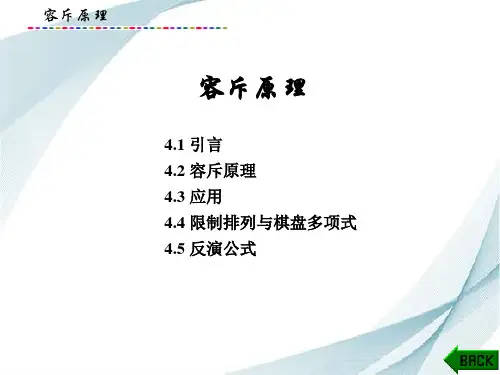
-----WORD格式--可编辑--专业资料----- --完整版学习资料分享---- 第五章 Pólya计数理论 1. 计算(123)(234)(5)(14)(23),并指出它的共轭类. 解:题中出现了5个不同的元素:分别是:1,2,3,4,5。即|Sn|=5。
5123454321524315432154132
54321
)23)(14)(5)(234)(123(
512345432152143
54321
53412
54321
)5)(34)(12( (5)(12)(34)的置换的型为1122而Sn中属于1122型的元素个数为1521!1!2!521个其共轭类为 (5)(14)(23),(5)(13)(24),(1)(23)(45),(1)(24)(35), (1)(25)(34),(2)(13)(45),(2)(14)(35),(2)(15)(34), (3)(12)(45),(3)(14)(25),(3)(15)(24),(4)(12)(35), (4)(13)(25),(4)(15)(24) 2. 设D是n元集合,G是D上的置换群.对于D的子集A和B,如果存在G,使得
}|)({AaaB,则称A与B是等价的.求G的等价类的个数.
解:根据Burnside引理niiacGl11)(1,其中c1(ai)表示在置换ai作用下保持不变的元素个数,则有 c1(σI)=n; 设在σ的作用下,A的元素在B中的个数为i,则 c2(σ)=n-2i;
若没有其他置换,则G诱出来的等价类个数为l=ininn)]2([21 3. 由0,1,6,8,9组成的n位数,如果把一个数调转过来读得到另一个数,则称这两个数是相等的.例如,0168和8910,0890与0680是相等的.问不相等的n位数有多少个? 解:该题可理解为相当于n位数,0,1,6,8,9这5个数存在一定的置换关系 对于置换群G={g1,g2} g1为不动点置换,型为1n;为5n; -----WORD格式--可编辑--专业资料----- --完整版学习资料分享---- g2置换:(1n)(2(n-1))(3(n-2))…(22nn)